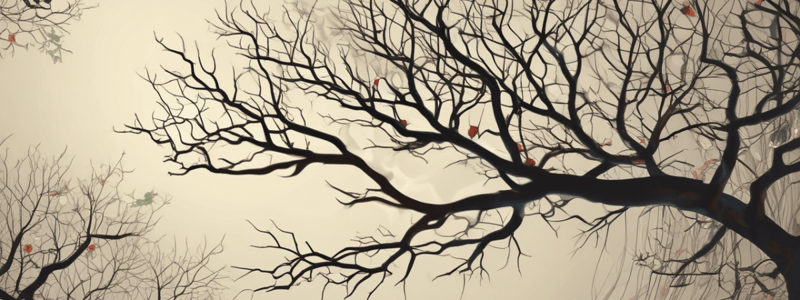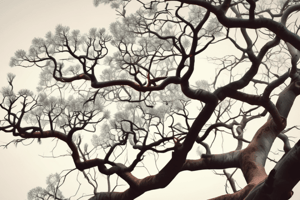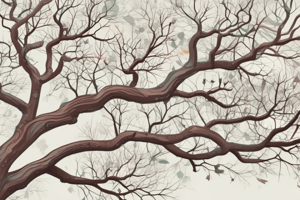Podcast
Questions and Answers
Which of the following is NOT a component of a cell?
Which of the following is NOT a component of a cell?
- Golgi apparatus (correct)
- Chloroplast
- Nucleus
- Mitochondria
What is the main function of mitochondria?
What is the main function of mitochondria?
- Cellular respiration (correct)
- Protein synthesis
- DNA replication
- Photosynthesis
Which process is responsible for the creation of gametes (sperm and egg cells)?
Which process is responsible for the creation of gametes (sperm and egg cells)?
- Meiosis (correct)
- Mitosis
- Cellular respiration
- Gene expression
What is the process by which organisms evolve over time in response to environmental pressures?
What is the process by which organisms evolve over time in response to environmental pressures?
Which of the following is a trait that helps an organism survive and reproduce in its environment?
Which of the following is a trait that helps an organism survive and reproduce in its environment?
Which process is responsible for converting the information in a gene's DNA into a functional product?
Which process is responsible for converting the information in a gene's DNA into a functional product?
What is the main focus of botany?
What is the main focus of botany?
What type of biology primarily focuses on the study of heredity and genetic information?
What type of biology primarily focuses on the study of heredity and genetic information?
Which biological molecules are responsible for energy storage and structure?
Which biological molecules are responsible for energy storage and structure?
What does the study of microbiology focus on?
What does the study of microbiology focus on?
Which branch of biology examines the structure and function of cells?
Which branch of biology examines the structure and function of cells?
Which of the following options best describes evolutionary biology?
Which of the following options best describes evolutionary biology?
Flashcards are hidden until you start studying
Study Notes
Branches of Biology
- Botany: study of plants and their interactions with the environment
- Zoology: study of animals and their interactions with the environment
- Microbiology: study of microorganisms such as bacteria, viruses, and fungi
- Ecology: study of the relationships between organisms and their environment
- Genetics: study of heredity, genes, and genetic information
- Biochemistry: study of the chemical processes that occur within living organisms
- Molecular Biology: study of the structure, function, and interactions of biological molecules
- Cell Biology: study of the structure, function, and behavior of cells
- Evolutionary Biology: study of the processes that have shaped the diversity of life on Earth
Biological Molecules
- Carbohydrates: provide energy and structure for organisms (e.g. sugars, starches, cellulose)
- Proteins: perform a wide range of functions in the body (e.g. enzymes, hormones, structural proteins)
- Lipids: provide energy and structure for organisms (e.g. fats, oils, cholesterol)
- Nucleic Acids: store and transmit genetic information (e.g. DNA, RNA)
Cell Structure and Function
- Cell Membrane: selectively permeable membrane that surrounds the cell
- Cytoplasm: jelly-like substance inside the cell membrane where metabolic processes occur
- Nucleus: contains the cell's genetic material
- Mitochondria: produce energy for the cell through cellular respiration
- Endoplasmic Reticulum: involved in protein synthesis and transport
- Ribosomes: site of protein synthesis
Biological Processes
- Photosynthesis: process by which plants and some other organisms produce energy from sunlight
- Cellular Respiration: process by which cells generate energy from glucose
- Gene Expression: process by which the information in a gene's DNA is converted into a functional product
- Meiosis: process by which gametes (sperm and egg cells) are produced
- Mitosis: process by which somatic cells divide to produce two daughter cells
Evolution
- Natural Selection: process by which populations evolve over time in response to environmental pressures
- Speciation: process by which a new species emerges from an existing one
- Phylogeny: study of the evolutionary relationships between organisms
- Adaptation: trait that has evolved to help an organism survive and reproduce in its environment
Branches of Biology
- Botany: Focuses on plant life and their environmental interactions, including growth, reproduction, and classification.
- Zoology: Examines animal species, their behaviors, and ecological dynamics with their habitats.
- Microbiology: Investigates microscopic organisms like bacteria, viruses, and fungi, exploring their roles in health and the ecosystem.
- Ecology: Studies the interrelationships between living organisms and their surroundings, emphasizing ecosystem balance and biodiversity.
- Genetics: Explores heredity, gene structure, mutation, and inheritance patterns among organisms.
- Biochemistry: Analyzes biochemical processes in organisms, including metabolism, enzyme function, and cellular signaling.
- Molecular Biology: Investigates biological molecules' interactions, focusing on DNA, RNA, and protein synthesis.
- Cell Biology: Analyzes cell structure and function, emphasizing cellular processes and communication.
- Evolutionary Biology: Explores the history of life on Earth, examining the mechanisms of evolution and species diversification.
Biological Molecules
- Carbohydrates: Serve as primary energy sources and structural components, comprising sugars, cellulose, and starches.
- Proteins: Involved in numerous bodily functions, including catalysis (enzymes), signaling (hormones), and structure (muscle fibers).
- Lipids: Provide energy storage and cellular structure; include fats, oils, and important molecules like cholesterol.
- Nucleic Acids: Consist of DNA and RNA, crucial for storing and transmitting genetic information and guiding protein synthesis.
Cell Structure and Function
- Cell Membrane: Acts as a selectively permeable boundary, regulating entry and exit of substances and offering protection.
- Cytoplasm: A gel-like fluid where cellular processes and reactions occur, housing organelles essential for function.
- Nucleus: Control center of the cell containing chromosomal DNA, regulating cell activity and hereditary information.
- Mitochondria: Powerhouse of the cell, responsible for converting glucose into usable energy through cellular respiration.
- Endoplasmic Reticulum: Plays a vital role in synthesizing proteins (rough ER) and lipids (smooth ER), facilitating transport throughout the cell.
- Ribosomes: Sites of protein synthesis, translating RNA into proteins essential for cellular function.
Biological Processes
- Photosynthesis: Allows autotrophs to convert sunlight into chemical energy, producing glucose and oxygen as byproducts.
- Cellular Respiration: A metabolic process where cells oxidize glucose, generating ATP (energy currency of the cell) and releasing carbon dioxide and water.
- Gene Expression: Involves transcription of DNA into RNA and translation into proteins, essential for cellular function and development.
- Meiosis: A specialized form of cell division creating gametes with half the number of chromosomes, facilitating sexual reproduction.
- Mitosis: A process of somatic cell division resulting in two genetically identical daughter cells, crucial for growth and tissue repair.
Evolution
- Natural Selection: Mechanism driving evolution, where advantageous traits enhance survival and reproductive success, altering population gene pools over time.
- Speciation: Formation of new species as populations adapt to different environments and genetic divergence occurs.
- Phylogeny: Systematic study that outlines evolutionary connections between organisms, often depicted through evolutionary trees.
- Adaptation: Evolutionary process leading to traits that improve an organism's capability to thrive in specific environmental conditions.
Studying That Suits You
Use AI to generate personalized quizzes and flashcards to suit your learning preferences.




